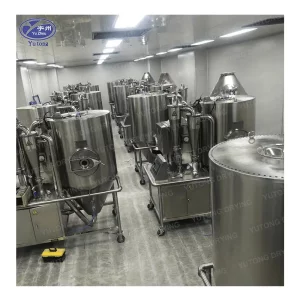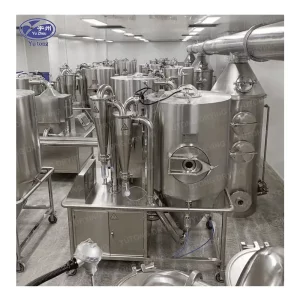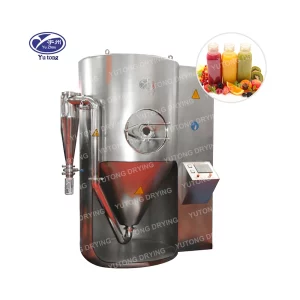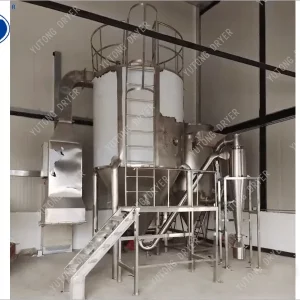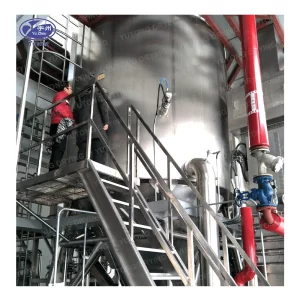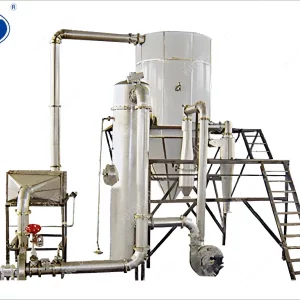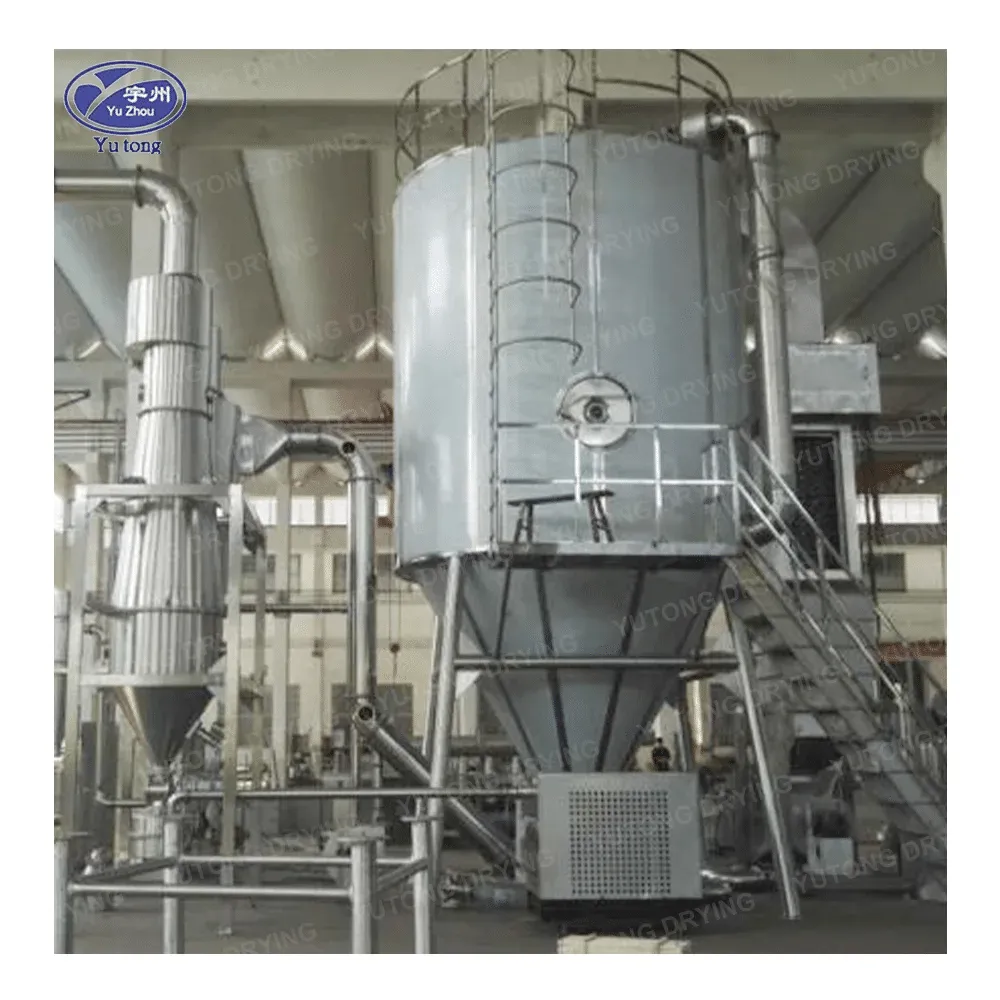In the realm of industrial processes, spray drying stands as a remarkable technique that has revolutionized the transformation of liquid substances into dry powders. This method holds significant importance across a wide spectrum of industries due to its unique capabilities and benefits. In this comprehensive article, we will delve deep into the various types of spray dryers, explore their numerous advantages, and examine the diverse applications where spray drying plays a crucial role.
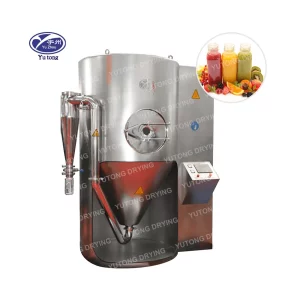
Understanding Spray Drying
Spray drying is a process that combines precision and efficiency. It begins by atomizing a liquid feed into extremely fine droplets. These droplets are then exposed to a hot gas stream, which rapidly evaporates the moisture, leaving behind dry powder particles. The science behind this process lies in the balance between the atomization technique, the temperature and flow rate of the hot gas, and the residence time of the droplets in the drying chamber.
Types of Spray Dryers
1. Single-Stage Spray Dryers
The most common and widely used type of spray dryer is the single-stage variant. It consists of several key components, including a drying chamber, an atomizer, a hot gas inlet, and a powder collector.
The liquid feed is introduced into the atomizer, which breaks it down into a fine mist of droplets. The hot gas, typically air or a combination of gases, enters the drying chamber and quickly dries the droplets as they pass through.
Single-stage spray dryers are highly versatile and can handle a wide range of liquid feeds with different viscosities and solid contents. They are suitable for various applications in industries such as food, pharmaceuticals, and chemicals.
For example, in the food industry, single-stage spray dryers are used to produce milk powder, instant coffee, and various flavorings. In the pharmaceutical sector, they are employed to create powders for tablets, capsules, and inhalation drugs.
2. Two-Stage Spray Dryers
Two-stage spray dryers offer an enhanced drying process for materials that are more difficult to dry completely in a single stage.
In the first stage, the liquid feed is atomized and dried in a manner similar to a single-stage dryer. However, the partially dried powder then enters a second stage, where it is further dried using a lower temperature gas stream.
This two-stage approach allows for a more controlled drying process and can result in powders with specific properties. For instance, in the production of certain pharmaceuticals, a two-stage spray dryer may be used to ensure a precise moisture content and particle size distribution.
Two-stage spray dryers are also useful for drying materials that require a gentler drying process to preserve their quality and activity.
3. Multistage Spray Dryers
Multistage spray dryers are the most complex and advanced type of spray dryer. They consist of multiple drying stages, each with its own atomizer and gas stream.
These dryers are designed for applications that require a very high degree of drying or the production of powders with extremely fine particle sizes.
Multistage spray dryers offer greater control over the drying process and can be customized to meet specific product requirements. However, they are also more expensive and require more complex operation and maintenance.
In industries such as advanced materials and nanotechnology, multistage spray dryers are used to produce powders with unique properties and characteristics.
Advantages of Spray Drying
1. High Drying Efficiency
One of the most significant advantages of spray drying is its high drying efficiency. The atomization process creates a large surface area for the hot gas to contact the liquid droplets, resulting in rapid evaporation of the moisture.
This leads to shorter drying times and higher production rates compared to other drying methods. For example, in the food industry, spray drying can produce large quantities of powdered products in a relatively short period, meeting the demands of mass production.
The high drying efficiency also means less energy consumption, making spray drying a more sustainable and cost-effective option in the long run.
2. Uniform Particle Size Distribution
The atomization process in spray drying produces droplets of uniform size, which in turn results in powders with a narrow particle size distribution. This uniformity is crucial for many applications as it can improve the flowability, solubility, and stability of the powder.
In the pharmaceutical industry, for instance, a uniform particle size is essential for ensuring the proper delivery and efficacy of drugs. It also allows for more accurate dosing and better control over the release of active ingredients.
The ability to control the particle size distribution gives manufacturers the flexibility to tailor the powder properties to meet specific application requirements.
3. Ability to Handle Heat-Sensitive Materials
Spray drying is particularly suitable for drying heat-sensitive materials as the drying process is rapid and the exposure to high temperatures is short. The hot gas stream quickly evaporates the moisture from the droplets, preventing the material from being exposed to prolonged high temperatures that could cause degradation.
This makes spray drying an ideal method for drying materials such as pharmaceuticals, food products, and biological materials. For example, in the production of vaccines and proteins, spray drying can preserve their activity and stability, ensuring their effectiveness.
Additionally, the gentle drying process can help maintain the integrity and quality of the material, reducing the risk of damage or loss of valuable properties.
4. Versatility
Spray drying is highly versatile and can handle a wide range of liquid feeds, including solutions, suspensions, emulsions, and pastes. It can also be used to dry materials with different viscosities and solid contents.
This versatility allows it to be applied in various industries and for different types of products. For instance, in the chemical industry, spray drying can be used to produce powders of pigments, dyes, catalysts, and other chemicals. In the cosmetics industry, it is used to create powders for makeup and skincare products.
Moreover, spray drying can be easily integrated into existing production processes, making it a convenient and practical option for many manufacturers.
Applications of Spray Drying
1. Pharmaceuticals
In the pharmaceutical industry, spray drying plays a vital role in the production of various dosage forms. Powders produced by spray drying are used for inhalation drugs, tablets, capsules, and other formulations.
The ability to control the particle size and morphology of the powder is crucial for ensuring the proper delivery and efficacy of the drug. For inhalation drugs, a specific particle size range is required to ensure that the drug reaches the lungs effectively.
Spray drying is also used to dry biological materials such as vaccines and proteins. The gentle drying process can preserve their activity and stability, making it an essential technique in the production of these important medical products.
2. Food Industry
The food industry relies on spray drying to produce a wide range of powdered ingredients. Milk powder, coffee creamer, instant soups, and flavorings are just some of the products made using spray drying.
The uniform particle size and good solubility of the powders make them easy to handle and use in food formulations. Spray drying can also be used to encapsulate flavors, vitamins, and other sensitive ingredients to protect them from degradation and improve their stability.
For example, encapsulated flavors can be released at specific times during the cooking or consumption process, enhancing the taste and aroma of the food.
3. Chemical Industry
In the chemical industry, spray drying is used to produce powders of pigments, dyes, catalysts, and other chemicals. The high drying efficiency and ability to handle different types of liquid feeds make it a suitable method for chemical processing.
Spray drying can also be used to produce nanomaterials and other advanced materials with specific properties. For instance, nanoparticles produced by spray drying can have unique optical, electrical, or magnetic properties, making them useful in various applications such as electronics, catalysis, and drug delivery.
4. Other Industries
Spray drying finds applications in other industries as well. In the cosmetics industry, it is used to produce powders for makeup and skincare products. The fine particle size and smooth texture of the powders make them ideal for these applications.
In the ceramics industry, spray drying is used to produce ceramic powders for advanced applications such as high-performance ceramics and 3D printing. The controlled particle size distribution and purity of the powders are essential for achieving the desired properties of the ceramic products.
In environmental engineering, spray drying is used to dry sludge and other waste materials. This helps to reduce the volume of waste and make it easier to handle and dispose of.
Spray drying is a remarkable technique that offers a wide range of benefits and applications. The different types of spray dryers available provide flexibility and customization options to meet the specific needs of various industries. The high drying efficiency, uniform particle size distribution, ability to handle heat-sensitive materials, and versatility make spray drying an invaluable tool in the production of powders for pharmaceuticals, food, chemicals, and other industries. As technology continues to advance, spray drying is likely to evolve and find even more applications in the future, further enhancing its importance in the industrial landscape.

